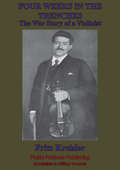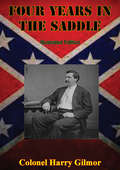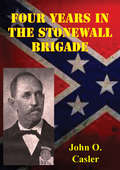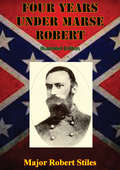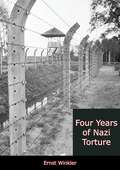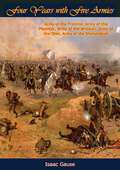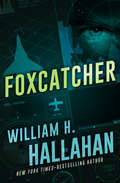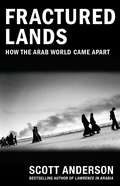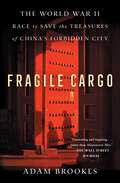- Table View
- List View
Four Relentless Days: Four Relentless Days (mission: Six) / In The Lawman's Protection (omega Sector: Under Siege) (Mission: Six)
by Elle JamesCaught in a web of dangerA SEAL will risk everythingSexy SEAL “Harm” Harmon Payne isn’t looking for love…or trouble. Until he encounters the prettiest creature on the savanna, Talia Montclair. The safari resort owner has been plagued by a series of threatening incidents. This kind of trouble Harm can handle. But when Talia mysteriously disappears, Harm’s SEAL instincts kick in. His new mission: find the only woman he has ever loved.Mission: Six
Four Shots in the Night: A True Story of Stakeknife, Murder and Justice in Northern Ireland
by Henry Hemming'A truly page-turning, compulsive and also profoundly moving narrative. Superb.' JAMES HOLLAND'Gripping, urgent, superbly reported and brilliantly written' DAN JONES'A gripping and pacey book that reads like a thriller. I found it shocking in a world where I didn't think I could be shocked any more. Henry Hemming wears his extensive research very lightly and manages to shape a great narrative from a complex and dark episode from our recent history. An important and skilfully crafted book.' JOHN O'FARRELLHOW THE DEATH OF A SPY IN THE IRA LED TO ONE OF THE BIGGEST MURDER INVESTIGATIONS IN BRITISH HISTORY. On 26th May 1986, the body of an undercover British agent was found by the side of a muddy lane, with a rope tied around its wrists and tape over each eye. Years later, it was reported that this murder might have been carried out by another undercover British agent, known as 'Stakeknife'. In 2016, a detective began to investigate this case, and would soon find himself running the largest murder investigation in British history.In a compulsive blend of investigative journalism and true crime thriller, Henry Hemming exposes the parallel worlds of the IRA and British intelligence through the lives of those inextricably bound up in both. He reveals the bravery of those who were crucial in ending the Troubles in Northern Ireland, the bloodiest and longest-running conflict in recent British history, and the determination of one detective in his dogged search for justice and the truth.'a compelling story' - The Times'[a] gripping and consistently surprising true-life thriller' - Observer
Four Shots in the Night: A True Story of Stakeknife, Murder and Justice in Northern Ireland
by Henry Hemming'A truly page-turning, compulsive and also profoundly moving narrative. Superb.' JAMES HOLLAND'Gripping, urgent, superbly reported and brilliantly written' DAN JONES'A gripping and pacey book that reads like a thriller. I found it shocking in a world where I didn't think I could be shocked any more. Henry Hemming wears his extensive research very lightly and manages to shape a great narrative from a complex and dark episode from our recent history. An important and skilfully crafted book.' JOHN O'FARRELLHOW THE DEATH OF A SPY IN THE IRA LED TO ONE OF THE BIGGEST MURDER INVESTIGATIONS IN BRITISH HISTORY. On 26th May 1986, the body of an undercover British agent was found by the side of a muddy lane, with a rope tied around its wrists and tape over each eye. Years later, it was reported that this murder might have been carried out by another undercover British agent, known as 'Stakeknife'. In 2016, a detective began to investigate this case, and would soon find himself running the largest murder investigation in British history.In a compulsive blend of investigative journalism and true crime thriller, Henry Hemming exposes the parallel worlds of the IRA and British intelligence through the lives of those inextricably bound up in both. He reveals the bravery of those who were crucial in ending the Troubles in Northern Ireland, the bloodiest and longest-running conflict in recent British history, and the determination of one detective in his dogged search for justice and the truth.'a compelling story' - The Times'[a] gripping and consistently surprising true-life thriller' - Observer
Four Stars Of Hell
by Laurence CritchellThe wartime exploits of the 501st Parachute Infantry Regiment are told here in the most vivid and appropriate way; by one of the men who experienced their battles firsthand - Captain Laurence Critchell. The author fought with the men of the Screaming Eagles from the tough training at camp Toccoa, Georgia to their hellish night drop on D-Day and all the way to the capture of Hitler's mountain retreat at Berchtesgaden. During 1944-1945 the author and his comrades soldiers would be involved in some of the heaviest and bloodiest fighting in Europe, during the Operation Market Garden at Njimegen and the Battle of the Bulge at Bastogne. A gripping read of the Second World War as told by a decorated combat veteran."It is fitting that the story of the 501st Parachute Regiment of the famed 101st Airborne Division should be told by a parachute captain."--The New York Times"A personalized record, told in terms of the men of all ranks, of how they trained and fought and died... the story has an authentic ring."--U.S. Quarterly"The greatest airborne operation of this or any other war." --Lewis H. Brereton, Former Lt. General, First Allied Airborne Army, World War II
Four Stars of Valor: The Combat History of the 505th Parachute Infantry Regiment in World War II
by Phil NordykeHailing from the big cities and small towns of America, these young men came together to serve their country and the greater good. They were the 505th Parachute Infantry Regiment of the 82nd Airborne Division (the All Americans). Phil Nordyke, their official historian, draws on interviews with surviving veterans and oral history recordings as well as official archives and unpublished written accounts from more than three hundred veterans of the 505th PIR and their supporting units. This is history as it was lived by the men of the 505th, from their prewar coming of age in the regiment, through the end of World War II, when they marched in the Victory Parade up Fifth Avenue in New York, to the postwar legacy of having been part of an elite parachute regiment with a record unsurpassed in the annals of combat.
Four Weeks In The Trenches; The War Story Of A Violinist [Illustrated Edition]
by Fritz KreislerFriedrich "Fritz" Kreisler was an Austrian-American violinist and composer of great renown, often regarded as one of the finest violinists of all time. He was, however, for a brief time an officer of the Austrian army during the First World War; but unlike the voluminous literature of Gallipoli and the Western Front in English, his memoirs of the fighting on the Eastern Front provide a rare insight seldom seen. Although clearly not a full record of the time that he spent in the Austrian service, before being honourably discharged after being wounded, the events that he chronicled are of considerable detail, artistic merit and lasting interest.
Four Weeks in the Trenches: The War Story of a Violinist
by Fritz KreislerFour weeks in the Trenches is the first-hand record of the experiences of Fritz Kreisler, one of the most renowned violinists of the twentieth century, during his service in the Austrian Army in World War I.
Four Years In The Saddle [Illustrated Edition]
by Colonel Harry GilmorIncludes Civil War Map and Illustrations Pack - 224 battle plans, campaign maps and detailed analyses of actions spanning the entire period of hostilities.The brutal occupation of Baltimore in 1861 by the Federal troops under Benjamin "Beast" Butler, would be the final straw for many Confederate leaning Marylanders. One such was Harry Gilmor, imprisoned for his political beliefs and his service in the Baltimore County Horse Guards, he was determined to join the Southern forces. As soon as he was released from prison he travelled as fast as possible to join the troops under Colonel Turner Ashby; by March 1862 he was commissioned as a captain of the Twelfth Virginia Cavalry. He set to his task with a passion earning much glory fighting under Jackson in the Valley campaign, even being entrusted with special missions by the great general himself. His military star was on the rise and he began to gain a sterling reputation as a cavalry commander often employed in scouting, raids and ambushes. He was in action at the Battle of Brandy Station, in the Shenandoah Valley and led the famous "Raid Round Baltimore" in 1864. Despite all his cunning and daring the tide of war turned against him and his Confederate comrades and he was captured in February 1865 in Hardy County. As a successful Confederate raider the Federal press had heaped calumnies upon him and his men, so after the war he wrote these memoirs to set the record straight.A dashing read of a famous Confederate cavalry officer.
Four Years In The Stonewall Brigade [Illustrated Edition]
by John O. CaslerIncludes more than 30 illustrations of the author's unit and the actions it engaged in."The classic tale of battle, roguery, and capture from the Army of Northern Virginia. From his looting of farmhouses during the Gettysburg campaign and robbing of fallen Union soldiers as opportunity allowed to his five arrests for infractions of military discipline and numerous unapproved leaves, John O. Casler's actions during the Civil War made him as much a rogue as a Rebel. Though he was no model soldier, his forthright confessions of his service years in the Army of Northern Virginia stand among the most sought after and cited accounts by a Confederate soldier. First published in 1893 and significantly revised and expanded in 1906, Casler's Four Years in the Stonewall Brigade recounts the truths of camp life, marches, and combat. Moreover, Casler's recollections provide an unapologetic view of the effects of the harsh life in Stonewall's ranks on an average foot soldier and his fellows. A native of Gainesboro, Virginia, with an inherent wanderlust and thirst for adventure, Casler enlisted in June 1861 in what became Company A, 33rd Virginia Infantry, and participated in major campaigns throughout the conflict, including Chancellorsville and Gettysburg. Captured in February 1865, he spent the final months of the war as a prisoner at Fort McHenry, Maryland. His postwar narrative recalls the realities of warfare for the private soldier, the moral ambiguities of thievery and survival at the front, and the deliberate cruelties of capture and imprisonment with the vivid detail, straightforward candor, and irreverent flair for storytelling that have earned "Four Years in the Stonewall Brigade" its place in the first rank of primary literature of the Confederacy."-Print ed.
Four Years Under Marse Robert [Illustrated Edition]
by Major Robert StilesIncludes Civil War Map and Illustrations Pack - 224 battle plans, campaign maps and detailed analyses of actions spanning the entire period of hostilities."Marse Robert" is one of the endearing nicknames by which General Robert E. Lee was called by his men. This book is the account of Robert Stiles' experience as a soldier during the Civil War. He traces his own story, giving personal significance to the battles fought and the time he spent under General Lee's command.Robert Stiles tells firsthand what a Confederate soldier experienced as he marched on and fought through great struggles and deprivation. He takes readers on the difficult journey through the Civil War battle by battle, while providing the personal analysis of an actual participant.
Four Years With General Lee [Illustrated Edition]
by Colonel W H TaylorIncludes Civil War Map and Illustrations Pack - 224 battle plans, campaign maps and detailed analyses of actions spanning the entire period of hostilities."...it offers a sure, quick, eyewitness assessment of all Lee's campaigns." --Southern PartisanColonel Taylor was the Adjutant-General of the Army of Northern Virginia, and Lee's right-hand man at Headquarters. Most of the orders and dispatches went out in Taylor's handwriting, and he was uniquely positioned to observe Lee's thinking and generalship close-up.In addition, Taylor was responsible for the "returns" (manpower statistics), and so is able to correlate the accounts of campaigns and battles with the actual strength of Confederate forces. The conclusion is inescapable: few military commanders have done more, with less, than Lee, and fewer still can have emerged with his reputation as a human being.The book concludes with the Address on the Character of General R.E. Lee, by Captain John Hampden Chamberlayne, delivered in 1876, which is a fine analysis on the career and character of the great General.
Four Years With the Iron Brigade: The Civil War Journals of William R. Ray, Co. F., Seventh Wisconsin Infantry
by Lance Herdegen Sherry MurphyBased on an major recent discovery-the Civil War as seen from the front ranks of a legendary fighting unit
Four Years of Nazi Torture
by Ernst WinklerErnst Winkler, a soldier and pilot under the Weimar Republic, resigned when Hitler came into power and accepted a position as one of the leaders of the Catholic Youth Movement. In 1934, he was arrested by the Gestapo when he refused army service because, as a devout Catholic, he opposed the Nazis, and subjected to a series of concentration camps and all manner of physical brutalities.On his return to his family in 1938, Winkler found them divided, his brothers Nazified. He left home and became part of the underground movement, broadcasting from mobile Freedom stations. Eventually, he was forced to escape to Switzerland, then over to France, and from France into Spain; his wife followed, and they reached their final destination by steamer: the United States.Four Years of Nazi Torture, which was first published during World War II in 1942, is author Ernst Winkler’s gruelling personal account of punishment without crime under the Nazi regime.“A terrible story—simply told”—Kirkus Reviews
Four Years with Five Armies: Army of the Frontier, Army of the Potomac, Army of the Missouri, Army of the Ohio, Army of the Shenandoah
by Isaac GauseIsaac Gause, served in Company E, 2nd Ohio Volunteer Cavalry Regiment, during the Civil War reaching the rank of sergeant. 2nd Ohio Volunteer Cavalry Regiment fought in the Knoxville Campaign, Battle of the Wilderness, Sheridan's Shenandoah Valley Campaign and finally the Appomattox Campaign. Gause served with distinction and went from a naïve teenage to a toughened NCO who would be awarded the Medal of Honor for capturing the colors of 8th South Carolina Infantry near Berryville.A vivid and exciting cavalry memoir from the Civil War.
Four Years with Morgan and Forrest [Illustrated Edition]
by Col. Thomas F. BerryIncludes Civil War Map and Illustrations Pack - 224 battle plans, campaign maps and detailed analyses of actions spanning the entire period of hostilities.First published in 1914, these are the recollections of Colonel Thomas Berry, taken from his diary kept during service in the Confederate Army when he served under Confederate General Nathan Bedford Forrest and General John Hunt Morgan during the Civil War.Berry’s narrative includes Morgan’s invasion into Indiana, Chickamauga, Rock Island prison, serving with General Joe Shelby in Mexico, escaping from the Yankees no less than thirteen times, and much more.A fascinating read.
Fourth Down (Game On #4)
by Desiree HoltGo Big or Go Home. When her relationship goes up in flames, Holly Funchess jumps straight back into the heat--by becoming a firefighter. Running as far away from her past as she can, Holly trains hard and lands a job with a small San Diego firehouse. With everything to prove, she has no problem putting her love life on the back burner. But where there's smoke... A former football player with a string of failed relationships behind him, Chase DeMarco has put his all into his Coast Guard career and the youth football team he coaches. He's not about to let anyone distract him--especially Holly, the woman at his gym who seems to relish getting under his skin. But when their skirmishes turn into full-contact workouts--and they face off against the dangers of their jobs--Chase and Holly must choose between letting the clock run down or playing to win..."Readers can't help but root for them to fall in love." -RT Book Reviews
Fourth Wing: DISCOVER THE GLOBAL PHENOMENON THAT EVERYONE CAN'T STOP TALKING ABOUT! (The Empyrean #1)
by Rebecca YarrosDON'T BE THE LAST TO DISCOVER THE SERIES THAT EVERYONE CAN'T STOP TALKING ABOUT:'Pure escapism - think Hunger Games meets Fifty Shades' The Sun'We weren't expecting to become obsessed . . . but we very much are and we're not alone' Sunday Times Style'This book contains an addictive, drug like essence that will make you relinquish all responsibility' Glamour 'Yarros had me hooked from the first chapter' Mail on Sunday__________________________________________FRIENDS. ENEMIES. LOVERS . . .EVERYONE HAS AN AGENDAViolet Sorrengail expected to live a quiet life surrounded by books, until she was forced onto the world's deadliest training ground. Now she must fight to join the army's elite: dragon riders. But dragons don't choose fragile riders, they incinerate them, and when your body breaks as easily as Violet's does - death is only a heartbeat away.EVERY NIGHT COULD BE YOUR LASTMany cadets would kill Violet to better their own chances of success; the rest would kill her just because of her last name . . . including the ruthless Xaden Riorson, her family's greatest enemy. With the odds stacked against her, Violet must use every edge her wits can give her just to see the next sunrise, because once you enter Basgiath War College, there are only two ways out:GRADUATE OR DIE__________________________________________ OVER ONE MILLION READERS HAVE ALREADY GIVEN FOURTH WING FIVE STARS. ARE YOU READY TO ENTER THE WORLD OF BASGIATH WAR COLLEGE? 'The new publishing sensation' Daily Mail'I couldn't put it down!' Millie Bobby Brown'If I can convince you to read one book I recommend it would be this one''I didn't sleep, I didn't eat, and when I finished, I had the overwhelming urge to just start it all over again''This book is probably the best fantasy book I have ever read''FIVE. FREAKING. STARS. There is no universe where I could give this book any less of a rating''There are some stories you read and enjoy but every so often you come across one that just obliterates everything and takes over your entire being within a few pages and becomes your world and personality. Well, this is the one''The world building in this was phenomenal. I lived, breathed and became a part of the college''You know when you finish a book, and it leaves an ache in your chest because it was so good, and now it's over? That's exactly how I feel after finishing Fourth Wing'OTHER BOOKS IN THE EMPYREAN SERIES:- FOURTH WING- IRON FLAME- ONYX STORM *Rebecca Yarros's Fourth Wing paperback was an instant number-one bestseller in the first week of April 2024.
Fox Girl
by Nora Okja KellerNora Okja Keller, the acclaimed author of Comfort Woman, tells the shocking story of a group of young people abandoned after the Korean War. At the center of the tale are two teenage girls—Hyun Jin and Sookie, a teenage prostitute kept by an American soldier—who form a makeshift family with Lobetto, a lost boy who scrapes together a living running errands and pimping for neighborhood girls. Both horrifying and moving, Fox Girl at once reveals another layer of war's human detritus and the fierce love between a mother and daughter. .
Foxbat (An Agent Paul Richter Thriller)
by James BarringtonStop the nuclear strike – at all costs…1976: A Russian pilot defects to Japan in a MiG-25 Foxbat interceptor, but is prematurely captured by the Americans. Before the aircraft is handed back to the Russians, it is reduced to a pile of components and then rebuilt. Despite the wealth of intelligence the Americans glean, however, they fail to realise its true purpose…The present day:American satellites have detected unusual activity at several Algerian air bases. At Aïn Oussera, a large hangar has been cordoned off and armed guards are posted outside. Western intelligence agencies suspect that Algeria might be launching an attack on Libya or Morocco. But they also have a greater concern: that these new weapons systems could be targeted by a rogue nuclear state. With global security in the balance, the only way to find the true threat is to get someone inside.Paul Richter is this ‘deniable asset’, called into action once more in a furiously exciting thriller, perfect for fans of Tom Clancy, Robert Ludlum or Mark Greaney.
Foxbats over Dimona: The Soviets' Nuclear Gamble in the Six-Day War
by Isabella Ginor Gideon RemezThe authors' groundbreaking history of the Six-Day War in 1967 radically changes our understanding of that conflict, casting it as a crucial arena of Cold War intrigue that has shaped the Middle East to this day.
Foxcatcher
by William H. HallahanFormer CIA agent Charlie Brewer finds himself the bait in a trap set by the United States and Iran. “Best thriller I’ve read in years” (The Washington Post). Meet Robert McCall, a man sinking deep into the seamy underside of intelligence work, into activities he knows are both illegal and immoral. Now McCall sees a chance to redeem himself by thwarting a daring plot to smuggle America’s most lethal high-tech war material to Iran. It’s a chance he’s ready to kill for. The likely victim: Charlie Brewer, a brilliant, embittered former intelligence operative who is desperate for answers. He was framed for an illegal arms deal and doesn’t know why; he’s been released from prison and doesn’t know why; he thinks he’s been marked for murder and doesn’t know why. When Brewer is approached by Iran’s most ruthless secret agent, he realizes treason may be the price of survival. “Up there with The Day of the Jackal for consistently sustained excitement.” —Gregory McDonald “The pace is smoothly breakneck, the plot wonderfully intricate and clear, the characters richly diverse. The pleasure of this satisfying thriller is increased by its effective humor and some delicious twists at the end.” —Publishers Weekly
Foxtrot in Kandahar: A Memoir of a CIA Officer in Afghanistan at the Inception of America's Longest War
by Duane EvansA thrilling true story of courage and duty after 9/11—“an extraordinary read from cover to cover . . . Gritty, frustrating, brutal, exhilarating” (Midwest Book Review). Within hours after the World Trade Center attacks in 2001, ex-Green Beret Duane Evans began a personal quest to become part of the US response against al-Qa’ida. His determination led him to join one of the CIAs elite teams bound for Afghanistan. It was a journey that eventually took him to the front lines in Pakistan—first as part of the advanced element of a CIA group supporting President Hamid Karzai, and finally as leader of the under-resourced and often overlooked Foxtrot team. Evans’s mission was to venture into southern Afghanistan, where the Taliban and al-Qa’ida held sway, and try to organize a cohesive resistance among the fractious warlords and tribal leaders. He traveled in the company of Pashtun warriors—one of only a handful of Americans pushing forward across the desert into some of the most dangerous, yet mesmerizingly beautiful, landscape on earth. Brilliantly crafted and fast-paced, Foxtrot in Kandahar “dramatically reports the huge challenges and exceptional success of [Evans’s] and his brothers’ work in Afghanistan defeating the Taliban and Al-Qaeda in nine weeks” (Ambassador Cofer Black, former director, Counterterrorist Center, CIA).
Fractured Lands: How the Arab World Came Apart
by Scott AndersonThe catastrophic story of how the Arab world has descended into chaos since the 2003 invasion of Iraq as told by the National Book Critics Circle Award finalist and international bestselling author of Lawrence in Arabia, a probing and insightful work of reportage.From world-renowned war correspondent, Scott Anderson, comes this gripping, human account of the unraveling of the Arab world, the rise of ISIS, and the global refugee crisis after the United States invasion of Iraq in 2003. Thisportrait of the region is framed by the stories of six individuals--the matriarch of a dissident Egyptian family, a Libyan Air Force cadet with divided loyalties, an Iraqi day-laborer turned ISIS fighter, a Kurdish doctor on leave from his practice to fight ISIS, a college student caught in the chaos of Aleppo, and an Iraqi women's rightsactivist targeted by militias. Through these personal stories, the myriad, complex causes of the widespread war and instability in the region come into focus and the concrete reality of the unspeakable tragedies occurring in the Middle East becomes clear.
Fractured Lands: How the Arab World Came Apart
by Scott AndersonFrom the bestselling author of Lawrence in Arabia, a piercing account of how the contemporary Arab world came to be riven by catastrophe since the 2003 United States invasion of Iraq.In 2011, a series of anti-government uprisings shook the Middle East and North Africa in what would become known as the Arab Spring. Few could predict that these convulsions, initially hailed in the West as a triumph of democracy, would give way to brutal civil war, the terrors of the Islamic State, and a global refugee crisis. But, as New York Times bestselling author Scott Anderson shows, the seeds of catastrophe had been sown long before. In this gripping account, Anderson examines the myriad complex causes of the region’s profound unraveling, tracing the ideological conflicts of the present to their origins in the United States invasion of Iraq in 2003 and beyond. From this investigation emerges a rare view into a land in upheaval through the eyes of six individuals—the matriarch of a dissident Egyptian family; a Libyan Air Force cadet with divided loyalties; a Kurdish physician from a prominent warrior clan; a Syrian university student caught in civil war; an Iraqi activist for women’s rights; and an Iraqi day laborer-turned-ISIS fighter. A probing and insightful work of reportage, Fractured Lands offers a penetrating portrait of the contemporary Arab world and brings the stunning realities of an unprecedented geopolitical tragedy into crystalline focus.
Fragile Cargo: The World War II Race to Save the Treasures of China's Forbidden City
by Adam BrookesThe gripping true story of the bold and determined museum curators who saved the priceless treasures of China&’s Forbidden City in the years leading up to World War II and beyond.Spring 1933: The silent courtyards and palaces of Peking&’s Forbidden City, for centuries the home of Chinese emperors, are tense with fear and expectation. Japan&’s aircrafts drone overhead, its troops and tanks are only hours away. All-out war between China and Japan is coming, and the curators of the Forbidden City are faced with an impossible question: how will they protect the vast imperial art collections in their charge? A difficult and monumental decision is made: to safeguard the treasures, they will need to be evacuated. The magnificent collections contain a million pieces of art—objects that carry China&’s deepest and most ancient memories. Among them are irreplaceable artefacts: exquisite paintings on silk, vanishingly rare Ming porcelain, and the extraordinary Stone Drums of Qin, which are adorned with 2,500-year-old inscriptions of crucial cultural significance. For sixteen terrifying years, under the quiet leadership of museum director Ma Heng, the curators would go on to transport the imperial art collections thousands of miles across China—up rivers of white water, across mountain ranges, and through burning cities. In their search for safety the curators and their fragile, invaluable cargo journeyed through the maelstrom of violence, chaos, and starvation that was China&’s Second World War. Told for the first time in English and playing out across a vast historical canvas, this is the exhilarating story of a small group of men and women who, when faced with war&’s onslaught on civilization, chose to resist. Fragile Cargo reminds us of the enduring power of beauty in a world beset by conflict and violence.
